Face Recognition Ai Camera Market Size and Trends
Global face recognition AI camera market is estimated to be valued at USD 3.78 Bn in 2025 and is expected to reach USD 15.73 Bn by 2032, exhibiting a compound annual growth rate (CAGR) of 22.6% from 2025 to 2032.
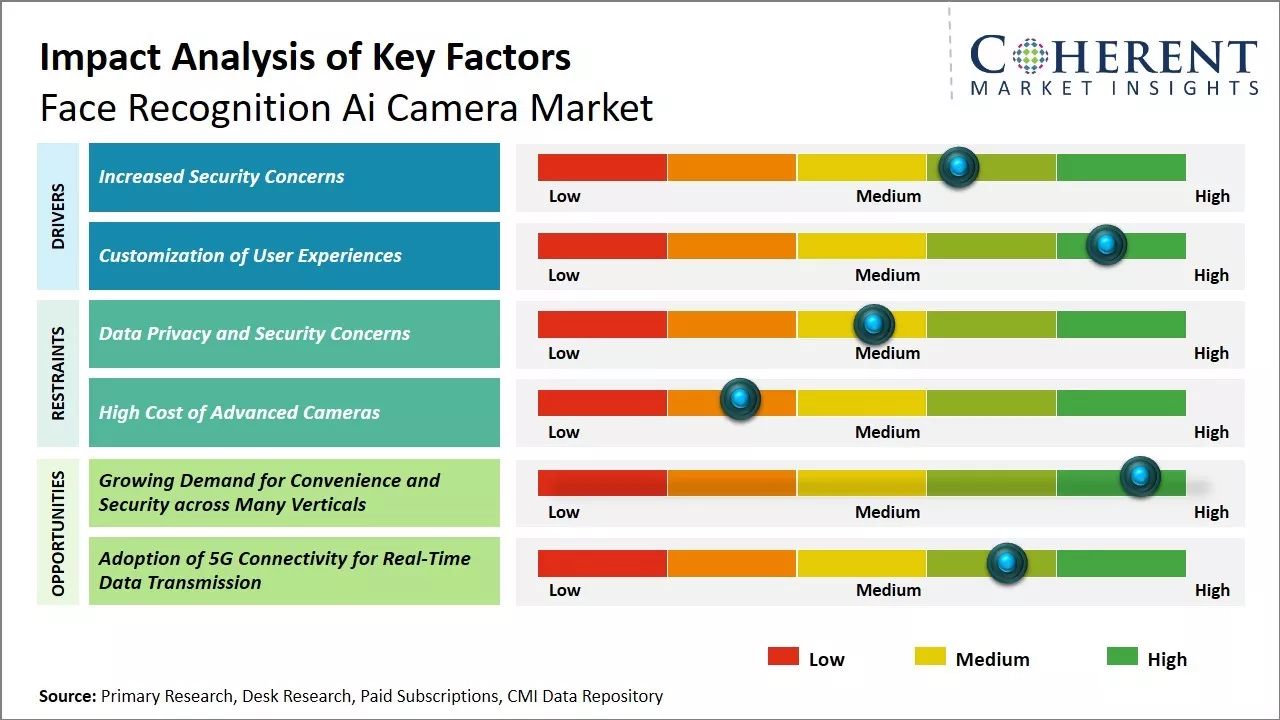
Discover market dynamics shaping the industry: Download Free Sample
The market is expected to witness significant growth during the forecast period due to increasing demand for safety and security across various industries. Face recognition cameras help organizations to identify individuals and monitor premises securely. These are being increasingly used across government buildings, commercial spaces, airports and retail stores to detect security breaches. Advancements in AI and machine learning (ML) have enabled more accurate real-time detection and recognition. Adoption of face recognition cameras is further expected to rise with declining prices of these cameras. Wide applications in attendance tracking, access control and law enforcement will further support face recognition camera market trends during the forecast period.
Increased Security Concerns
The use of face recognition technology in cameras is becoming increasingly widespread due to growing security concerns. With rising levels of crime and terrorism around the world, governments and law enforcement agencies are under tremendous pressure to enhance security screening at public venues like airports, railway stations, and government buildings. Face recognition cameras allow for a non-intrusive method of identifying individuals and alerting authorities in real-time if a known threat is detected.
Private businesses are also ramping up security through facial recognition systems to monitor entry and exit points in office complexes, retail stores, and factories. High-profile incidents of theft, fraud, and vandalism have pushed organizations to seek advanced identification tools beyond traditional ID cards and access systems. Face recognition cameras paired with watchlists and surveillance feeds offer a solution for continuously monitoring large public areas and restricted zones. The ability to quickly verify employee and visitor credentials as well as identify trespassers and intruders appeals to security managers tasked with protecting valuable infrastructure and proprietary information. With a growing digital footprint of people online, face recognition cameras have become a preferred biometric authentication method versus security tokens or passwords that can be lost or stolen.
For instance, in February 2025, Government of Gauteng, South Africa launched a network of nearly 7,000 surveillance cameras equipped with facial recognition software in an effort to reduce crime.
Market Concentration and Competitive Landscape
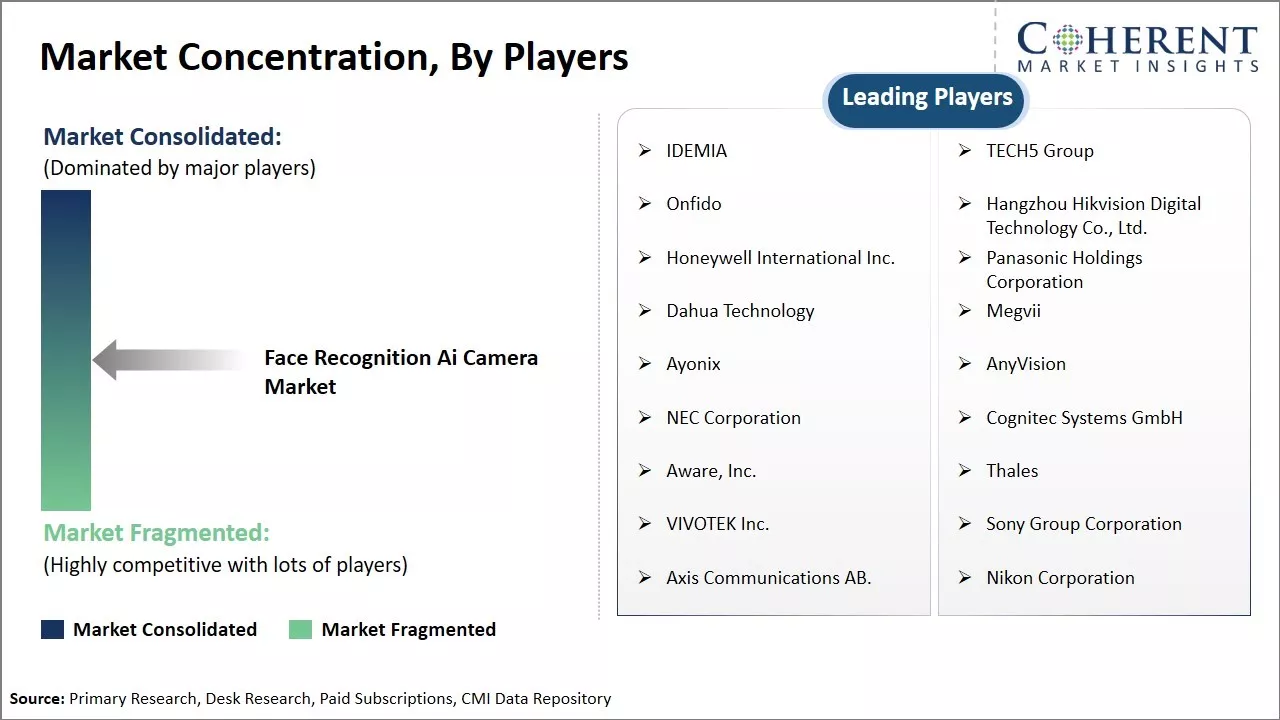
Get actionable strategies to beat competition: Download Free Sample
Customization of User ExperiencesAnother key driver for face recognition camera adoption is the potential for customized user experiences based on identification. As artificial intelligence (AI) and machine learning (ML) technologies advance rapidly, facial features extracted from cameras are enabling new applications well beyond security. Smart city infrastructure incorporating face recognition capabilities now aims to streamline civic services and create personalized engagements. Digital city kiosks and info-points can recognize frequent visitors to automatically load their preferred language settings, payment methods, and service requests. Queuing systems in government offices and transport hubs will be able to alert staff of VIP clients requiring priority attention.
In the consumer realm, face authentication allows for more seamless experiences across multiple personal devices. Logging into laptops, phones, TVs and smart home systems becomes frictionless when identity can be verified with a glance at a camera. E-commerce and online streaming platforms are exploring ways to deliver hyper-personalized content and recommendations based on facial profiles of individual household members. Advanced cameras may soon understand emotions and gauge reaction to ads, shows or products to optimize customer engagement.
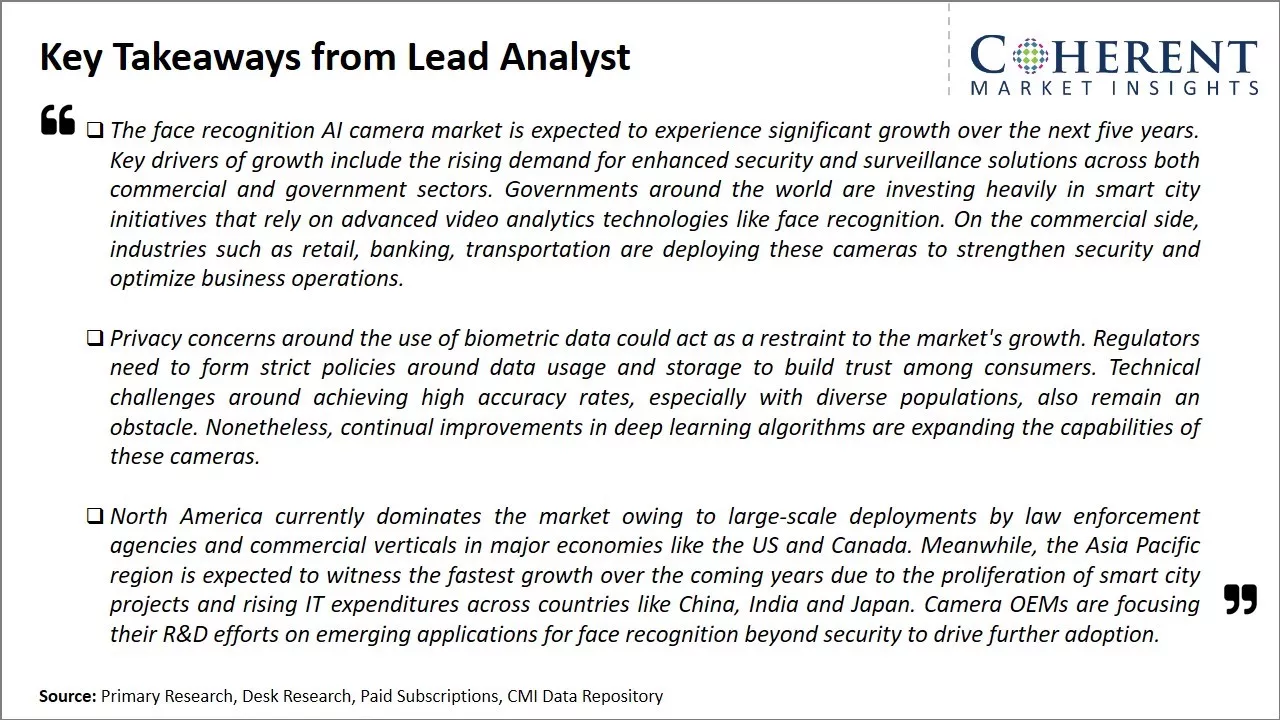
To learn more about this report, Download Free Sample
Market Challenges: Data Privacy and Security ConcernsOne of the major challenges faced by the face recognition AI camera market is data privacy and security concerns. As these cameras operate by collecting and storing facial images, there are legitimate worries around how this sensitive personal data will be stored, protected from hackers or leaks, and used by companies. Gaining consumer trust on privacy will be important for growth. Another hurdle is the need for further advances in technology to achieve more accurate recognition across variations in lighting, age, pose, and other facial attributes to expand use cases.
Market Opportunities: Growing Demand for Convenience and Security across Many Verticals
Growing demand for convenience and security across many verticals presents sizable opportunities. Wide deployment of these cameras in areas like consumer electronics, transportation hubs, commercial buildings, and smart cities could drive the revenue.
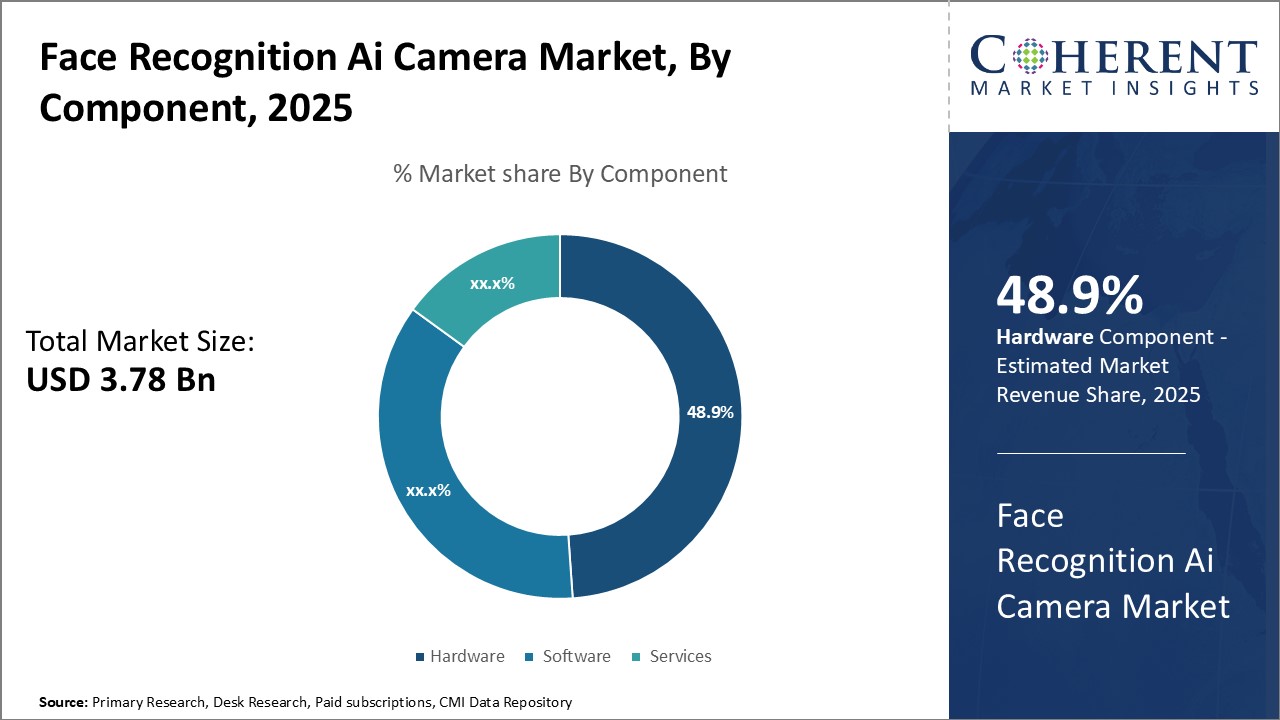
Discover high revenue pocket segments and roadmap to it: Download Free Sample
Insights, By Component- Hardware segment dominates due to higher investments in physical camerasBy component, hardware segment is estimated to contribute the largest share of 48.9% in 2025 due to higher investments made by organizations in installing physical cameras. Hardware forms the core of any surveillance or security system and accounts for a major portion of overall costs. Compared to software which can be installed on existing devices or updated remotely, hardware requires setting up physical infrastructure by purchasing cameras, lenses, cabling, and other accessory equipment. This leads to higher one-time capital expenditure for organizations.
Moreover, hardware is needed across various industry verticals for diverse applications like controlling entry/exit points in buildings, monitoring employee attendance, and visitors, and enhancing security around sensitive facilities. As the number of use cases rises, more cameras are added, resulting in continued demand and purchases of hardware components. Manufacturers also focus on launching new models with advanced features like higher megapixels, night vision, 360-degree panoramic view, and others to drive replacement cycles. This planned obsolescence of devices prompts recurring hardware sales.
Governments around the world have also ramped up investments in city-wide surveillance networks and smart infrastructure projects utilizing facial recognition. Mega-events and venues with huge footfalls rely on AI-powered cameras to monitor crowds and ensure safety. All these massive deployments involve setting up thousands of cameras connected to centralized controls rooms, thus benefiting hardware vendors. On the other hand, software licenses are one-time and does not need frequent configuration at site.
While software advancements are crucial, hardware provides the fundamental platform for facial biometrics to function and is irreplaceable. Even as AI models get more sophisticated, the physical sensors and imaging components embedded in cameras contribute maximum value. Therefore, hardware will remain the backbone and dominant segment within the face recognition AI camera market in the near future.
Insights, By Application - Access Control Leads in Applications due to Tighter Security Needs
The access control has emerged as the largest sub-segment in the face recognition AI camera market and is estimated to hold the market share of 42.8% in 2025. With security becoming a top priority amid rising threats, controlling entry gates and doors using biometric authentication has gained widespread acceptance. Facial recognition offers a non-intrusive and hands-free alternative to ID cards, fingerprints or passwords.
Critical infrastructures like government buildings, nuclear plants, airports and seaports have implemented biometric access control systems covering all entrance and exit points to strengthen perimeter protection. Even corporate offices are installing AI cameras paired with smart locks at main lobby desks and restricted areas. This not only logs visitor details but also prevents tailgating or piggybacking incidents. Workers appreciate the convenience while employers ensure only authorized identities can access sensitive zones or assets.
The education sector has also warmed up to face-based access systems for campus security. Universities manage student/staff entries into classrooms, labs and dormitories through a centralized database of registered faces. Attendance short-fall or trespassers can be detected in real-time. Similarly, hospitals leverage facial authentication for patient and doctor identification at registration counters, operation theatres, pharmacy, and emergency rooms to avoid mix-ups or frauds.
For instance, Vivotek, a security surveillance solutions provider, offers FD9387-FR-v2 facial recognition camera that suits banks’, retailers, and buildings’ automation/access control systems. It can integrate with business intelligence (BI) services to send real-time notifications when VIP customers enter the premises.
Insights, by Industry Vertical - Banking & Finance Institutes adopt Surveillance for Fraud Prevention
The BFSI segment has emerged as the top adopter of facial recognition AI cameras mainly for surveillance and security purposes. The segment is estimated to hold the market share of 32.1% in 2025. With massive financial transactions handled daily and valuable customer data at stake, preventing internal and external threats is crucial for maintaining customer trust in institutions.
AI cameras with facial matching are installed extensively across bank branches to monitor employee activities for any suspicious behaviour. Tellers handling large cash withdrawals are continuously tracked to detect frauds like passing confidential details to outsiders or staging robberies. Back-office employees involved in financing, lending or investment activities also face surveillance to prevent data leaks, money laundering or embezzlement that could cost billions in losses for banks.
Moreover, AI cameras scanning customer entries/exits and activities within premises help investigate past incidents that are related to identity thefts reported by clients. Stolen credit cards or impersonation scams are investigated through facial search within archived video footage. This assists police investigations as well.
Insurance companies similarly rely on AI-powered cameras to flag unauthorized access in claims processing areas, underwriting zones, and secure document storage vaults. Overall, around 60-70% of total cameras are installed by banking, financial services, and insurance vertical are for continuous monitoring applications as any security breach can dent their reputation and result in huge financial and legal costs. Therefore, surveillance emerges as the primary driver of facial recognition adoption in this industry.
Regional Insights
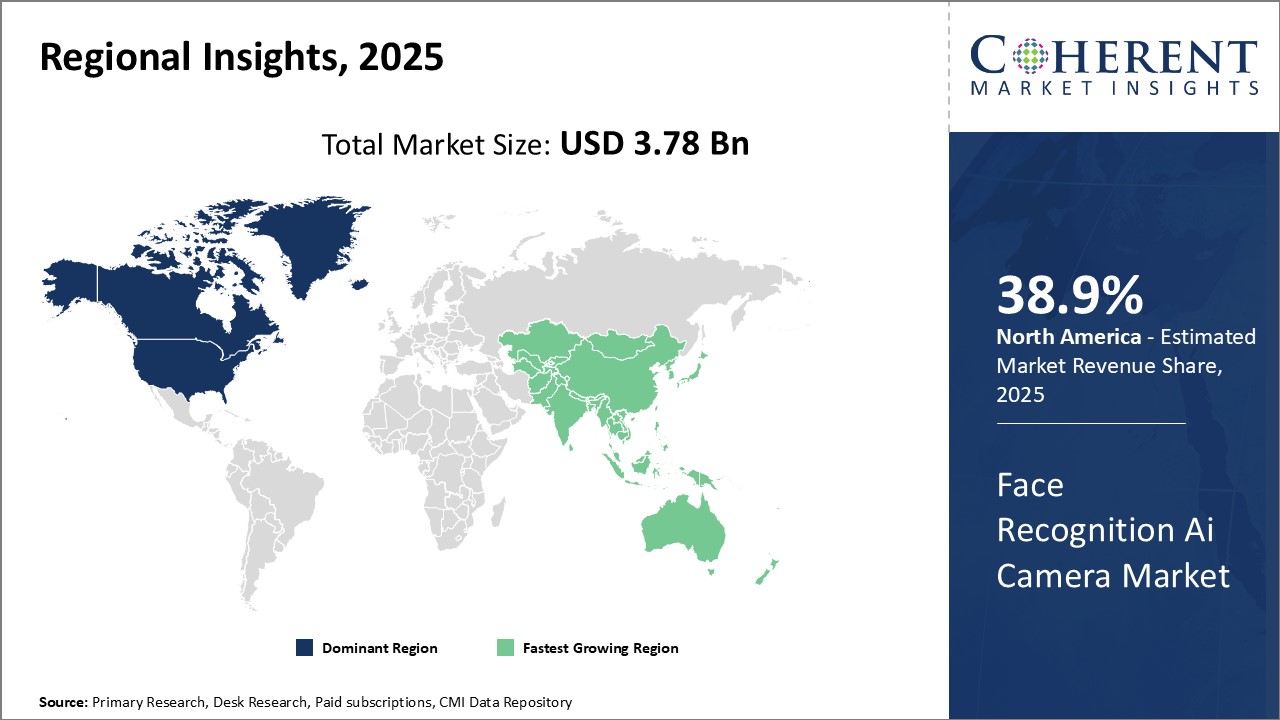
Need a Different Region or Segment? Download Free Sample
The North America region dominates the global face recognition AI camera market. The region is estimated to hold the market share of 38.9% in 2025. With a widespread presence of technology giants and major security equipment manufacturers based in the U.S. and Canada, the region is at the forefront of developing and adopting new AI and computer vision technologies. A large domestic market and high per capita expenditure on security solutions have enabled regular launches of advanced AI cameras.
Many North American governments and law enforcement agencies have also proactively deployed face recognition systems for surveillance and access control applications. This is creating a reliable demand for specialized AI cameras. Major cities like New York, Chicago, and Los Angeles have all rolled out facial identification programs at various facilities. Remote monitoring needs such as border security further support the regional market.
The Asia Pacific region has emerged as the fastest growing market for face recognition AI cameras globally. Countries like China, Japan, and South Korea have established themselves as hubs for electronics manufacturing and are quickly building AI capabilities. Local manufacturers are swiftly launching cost-effective networked cameras with deep learning-based facial analysis features.
Government initiatives focusing on public safety and smart city infrastructure are also propelling large-scale deployments across major Asia Pacific (APAC) urban centres. Applications in sectors such as retail, transportation, and education are experiencing high installation rates. Some regional economies are heavily investing in video surveillance networks along with made in [region] programs for biometrics technologies. This is attracting global camera brands to ramp up local production and export hubs in the area.
Overall, the APAC region's digital transformation and expanding base of AI camera suppliers/integrators have made it the new hotspot for future market expansion. The strong exports from regional players are also enhancing their global presence. While North America currently has an edge in the face recognition AI cameras space due to early technology leadership, the Asia Pacific region is rapidly emerging as the most promising market driven by the right industry and government level support factors.
Market Report Scope
Face Recognition Ai Camera Market Report Coverage
| Report Coverage | Details | ||
|---|---|---|---|
| Base Year: | 2024 | Market Size in 2025: | USD 3.78 Bn |
| Historical Data for: | 2020 To 2024 | Forecast Period: | 2025 To 2032 |
| Forecast Period 2025 to 2032 CAGR: | 22.6% | 2032 Value Projection: | USD 15.73 Bn |
| Geographies covered: |
|
||
| Segments covered: |
|
||
| Companies covered: |
IDEMIA , TECH5 Group, Onfido, Hangzhou Hikvision Digital Technology Co., Ltd. , Honeywell International Inc., Panasonic Holdings Corporation, Dahua Technology, Megvii, Ayonix , AnyVision, NEC Corporation, Cognitec Systems GmbH, Aware, Inc., Thales, VIVOTEK Inc., Sony Group Corporation, Axis Communications AB. , Nikon Corporation |
||
| Growth Drivers: |
|
||
| Restraints & Challenges: |
|
||
Uncover macros and micros vetted on 75+ parameters: Get instant access to report
Face Recognition Ai Camera Industry News
- In February 2024, NEC Corporation claimed the highest biometric accuracy score in four of eight categories in the latest assessment from the U.S. National Institute of Standards and Technology’s 1:N Identification track, as of the January 22, 2024
- In March 2023, Vivotek, a security surveillance solutions provider, launched its first facial recognition camera, FD9387-FR-v2, that combines edge computing to identify gender and age from video footage even when people wear masks
- In March 2023, Sony Electronics, a electronics manufacturing company, launched the new ZV-E1, an interchangeable lens camera with a high performance 35mm full-frame image sensor with various features such as multiple face recognition, auto framing, framing stabilizer and even auto microphone directivity
- In December 2022, Innovatrics, a Europe-based provider of multimodal biometric solutions, established collaborative partnership with Hailo, a company that offers microprocessor for AI applications, to develop facial recognition solutions with high energy efficiency and easy deployment for public security and access control.
*Definition: Global face recognition AI camera market consists of advanced camera systems that utilize artificial intelligence (AI) and computer vision technology to detect, analyse, and identify human faces in images and video streams. These smart cameras can match detected faces against watchlists and databases to verify people's identities for security and access control applications. The face recognition AI camera market is growing rapidly as these technologies are being adopted by businesses, government agencies, and other organizations looking for contactless solutions to authenticate users and enhance security surveillance systems.
Market Segmentation
- Component Insights (Revenue, USD BN, 2020 - 2032)
- Hardware
- Software
- Services
- Application Insights (Revenue, USD BN, 2020 - 2032)
- Access Control
- Security & Surveillance
- Attendance Tracking and Monitoring
- Others
- Industry Vertical Insights (Revenue, USD BN, 2020 - 2032)
- BFSI
- Retail & e-Commerce
- Healthcare
- Education
- Government
- Aerospace & Defence
- Others
- Regional Insights (Revenue, USD BN, 2020 - 2032)
- North America
- U.S.
- Canada
- Latin America
- Brazil
- Argentina
- Mexico
- Rest of Latin America
- Europe
- Germany
- U.K.
- Spain
- France
- Italy
- Russia
- Rest of Europe
- Asia Pacific
- China
- India
- Japan
- Australia
- South Korea
- ASEAN
- Rest of Asia Pacific
- Middle East & Africa
- GCC Countries
- Israel
- Rest of Middle East
- North America
- Key Players Insights
- IDEMIA
- TECH5 Group
- Onfido
- Hangzhou Hikvision Digital Technology Co., Ltd.
- Honeywell International Inc.
- Panasonic Holdings Corporation
- Dahua Technology
- Megvii
- Ayonix
- AnyVision
- NEC Corporation
- Cognitec Systems GmbH
- Aware, Inc.
- Thales
- VIVOTEK Inc.
- Sony Group Corporation
- Axis Communications AB.
- Nikon Corporation
Share
Share
About Author
Monica Shevgan has 9+ years of experience in market research and business consulting driving client-centric product delivery of the Information and Communication Technology (ICT) team, enhancing client experiences, and shaping business strategy for optimal outcomes. Passionate about client success.
Missing comfort of reading report in your local language? Find your preferred language :
Transform your Strategy with Exclusive Trending Reports :
Frequently Asked Questions
EXISTING CLIENTELE
Joining thousands of companies around the world committed to making the Excellent Business Solutions.
View All Our Clients
